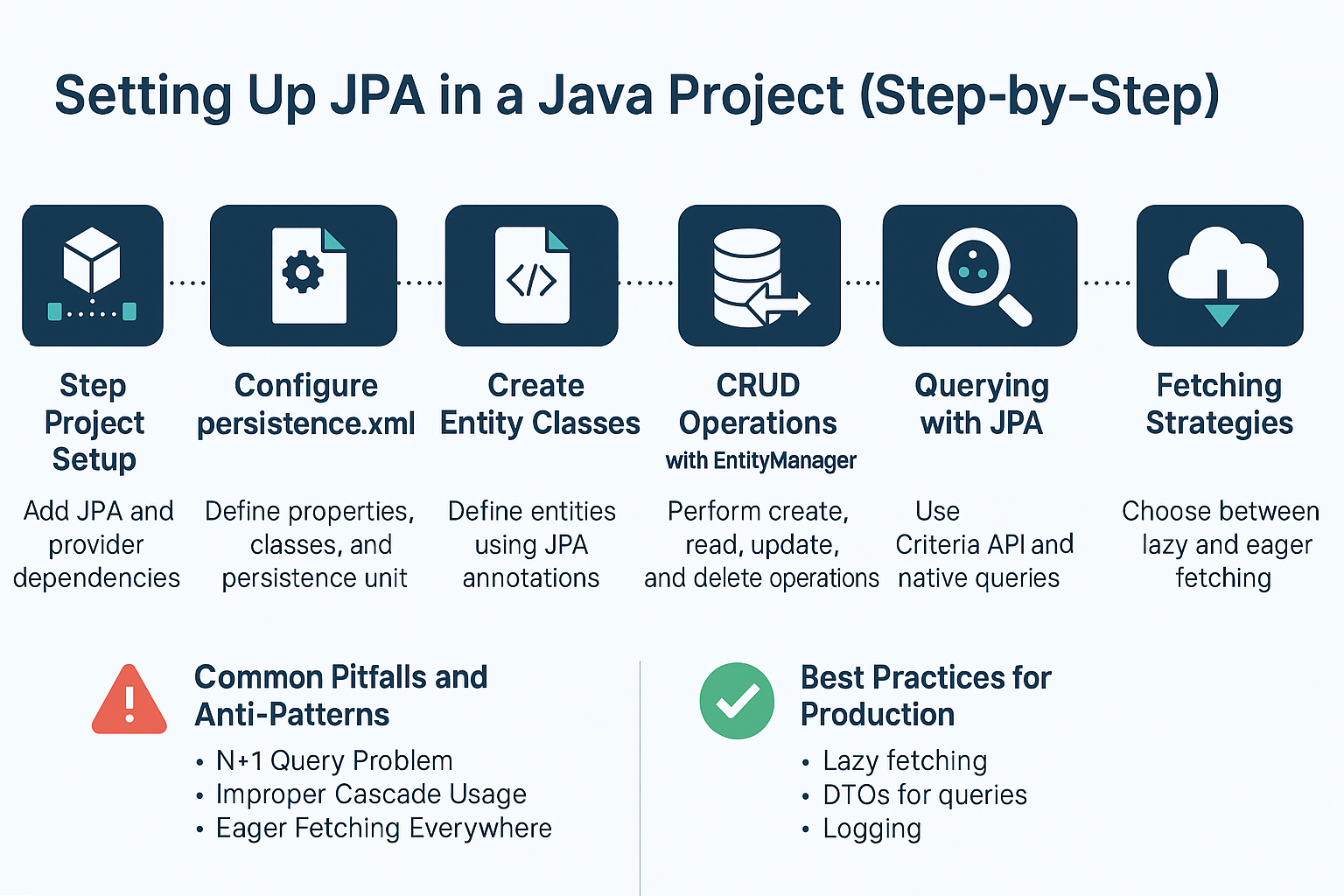When building enterprise-grade Java applications, managing database operations efficiently is crucial. Instead of writing verbose JDBC code for every query, the Java Persistence API (JPA) provides a standardized way to map Java objects to relational databases using ORM (Object Relational Mapping).
In this tutorial, we’ll cover the complete step-by-step setup of JPA in a Java project — from configuration to CRUD operations, querying, performance tuning, and best practices.
What is JPA?
- JPA (Java Persistence API) is a specification that defines how Java objects interact with relational databases.
- It provides an abstraction layer between Java code and SQL, reducing boilerplate code.
- Popular JPA providers include Hibernate, EclipseLink, and OpenJPA.
Analogy: JPA is the blueprint, Hibernate is the builder, and JDBC is the raw cement and bricks.
Step 1: Project Setup
Maven Dependency
<dependencies>
<!-- JPA API -->
<dependency>
<groupId>jakarta.persistence</groupId>
<artifactId>jakarta.persistence-api</artifactId>
<version>3.1.0</version>
</dependency>
<!-- Hibernate as JPA Implementation -->
<dependency>
<groupId>org.hibernate</groupId>
<artifactId>hibernate-core</artifactId>
<version>6.2.5.Final</version>
</dependency>
<!-- H2 Database (In-Memory) -->
<dependency>
<groupId>com.h2database</groupId>
<artifactId>h2</artifactId>
<scope>runtime</scope>
</dependency>
</dependencies>
Step 2: Configure persistence.xml
Place persistence.xml inside src/main/resources/META-INF/.
<persistence xmlns="https://jakarta.ee/xml/ns/persistence" version="3.0">
<persistence-unit name="examplePU">
<class>com.example.model.User</class>
<properties>
<property name="jakarta.persistence.jdbc.driver" value="org.h2.Driver"/>
<property name="jakarta.persistence.jdbc.url" value="jdbc:h2:mem:testdb"/>
<property name="jakarta.persistence.jdbc.user" value="sa"/>
<property name="jakarta.persistence.jdbc.password" value=""/>
<property name="hibernate.dialect" value="org.hibernate.dialect.H2Dialect"/>
<property name="hibernate.hbm2ddl.auto" value="update"/>
<property name="hibernate.show_sql" value="true"/>
</properties>
</persistence-unit>
</persistence>
Step 3: Create Entity Classes
User Entity Example
import jakarta.persistence.*;
@Entity
@Table(name = "users")
public class User {
@Id
@GeneratedValue(strategy = GenerationType.IDENTITY)
private Long id;
private String name;
@Column(unique = true, nullable = false)
private String email;
// Getters & Setters
}
Relationship Example
@Entity
@Table(name = "orders")
public class Order {
@Id
@GeneratedValue(strategy = GenerationType.IDENTITY)
private Long id;
private String product;
@ManyToOne
@JoinColumn(name = "user_id")
private User user;
}
Step 4: CRUD Operations with EntityManager
EntityManagerFactory emf = Persistence.createEntityManagerFactory("examplePU");
EntityManager em = emf.createEntityManager();
// Create
em.getTransaction().begin();
User user = new User();
user.setName("Alice");
user.setEmail("alice@example.com");
em.persist(user);
em.getTransaction().commit();
// Read
User found = em.find(User.class, user.getId());
// Update
em.getTransaction().begin();
found.setName("Alice Updated");
em.merge(found);
em.getTransaction().commit();
// Delete
em.getTransaction().begin();
em.remove(found);
em.getTransaction().commit();
em.close();
emf.close();
Step 5: Querying with JPA
JPQL (Object-Oriented Queries)
List<User> users = em.createQuery("SELECT u FROM User u WHERE u.name = :name", User.class)
.setParameter("name", "Alice")
.getResultList();
Criteria API
CriteriaBuilder cb = em.getCriteriaBuilder();
CriteriaQuery<User> query = cb.createQuery(User.class);
Root<User> root = query.from(User.class);
query.select(root).where(cb.equal(root.get("email"), "alice@example.com"));
List<User> results = em.createQuery(query).getResultList();
Native SQL
List<Object[]> results = em.createNativeQuery("SELECT * FROM users").getResultList();
Step 6: Fetching Strategies
- Lazy Fetching (default): Loads data only when accessed.
- Eager Fetching: Loads related data immediately.
Analogy: Lazy fetching = ordering food only when hungry, eager fetching = ordering everything upfront.
@OneToMany(mappedBy = "user", fetch = FetchType.LAZY)
private List<Order> orders;
Common Pitfalls and Anti-Patterns
- N+1 Query Problem: Occurs when fetching related entities lazily without JOIN FETCH.
- Improper Cascade Usage: Overusing
CascadeType.ALLcan lead to data loss. - Eager Fetching Everywhere: Causes performance bottlenecks.
Best Practices for Production
- Prefer lazy fetching with
JOIN FETCHwhen necessary. - Use DTOs (Data Transfer Objects) for read-heavy queries.
- Always define proper indexes at the DB level.
- Monitor SQL queries in logs for optimization.
📌 JPA Version Notes
- JPA 2.0: Introduced Criteria API, Metamodel.
- JPA 2.1: Added stored procedures, entity graphs.
- Jakarta Persistence (EE 9/10/11): Migrated from
javax.persistence→jakarta.persistence.
Real-World Integration
Spring Boot Example
@Repository
public interface UserRepository extends JpaRepository<User, Long> {
List<User> findByEmail(String email);
}
Spring Data JPA eliminates boilerplate CRUD code.
Jakarta EE Example
@Stateless
public class UserService {
@PersistenceContext
private EntityManager em;
public void saveUser(User user) {
em.persist(user);
}
}
Conclusion and Key Takeaways
- JPA abstracts database interaction and simplifies CRUD operations.
- Proper configuration ensures portability across databases.
- Use lazy fetching, DTOs, and query optimization for performance.
- Choose the right provider (Hibernate, EclipseLink) based on project needs.
FAQ
1. What’s the difference between JPA and Hibernate?
JPA is a specification, Hibernate is one of its implementations.
2. How does JPA handle the persistence context?
It acts like a register, keeping track of managed entities.
3. What are drawbacks of eager fetching?
It loads unnecessary data, wasting memory and CPU.
4. How can I solve the N+1 select problem?
Use JOIN FETCH or entity graphs.
5. Can I use JPA without Hibernate?
Yes, you can use EclipseLink, OpenJPA, or other providers.
6. What’s the best inheritance mapping strategy?SINGLE_TABLE is fastest; JOINED is normalized; TABLE_PER_CLASS is least used.
7. How does JPA handle composite keys?
By using @IdClass or @EmbeddedId.
8. What changes with Jakarta Persistence?
Namespace moved from javax.persistence to jakarta.persistence.
9. Is JPA suitable for microservices?
Yes, but avoid long-lived transactions and prefer DTOs.
10. When should I avoid using JPA?
When working with high-throughput analytics or NoSQL databases.
